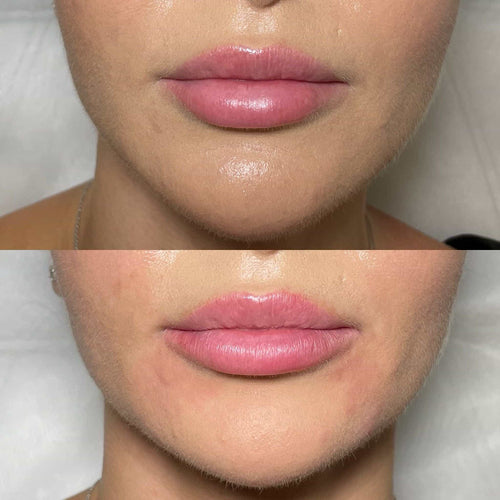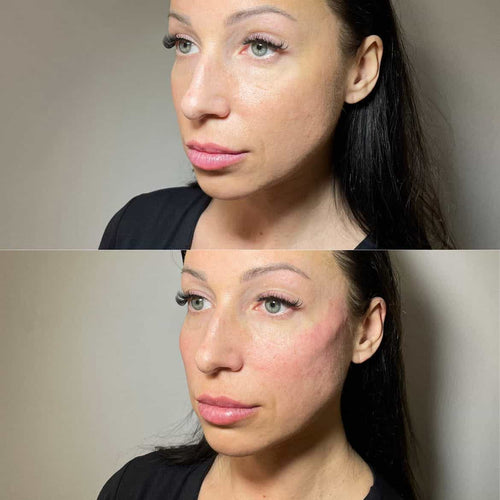Book Your Dermal Filler Appointment with Dr. Laura Geige
Common Signs of Lip Filler Migration
Asymmetry
Lip filler migration occurs when the hyaluronic acid gel used to augment lips moves from its original injection site.
Recognizing early signs is crucial for timely intervention and minimizing potential complications.

Here are some common signs of lip filler migration:
-
Lumpy or uneven texture:
Feel any noticeable bumps, lumps, or an uneven surface on your lips. This could indicate filler moving outside the injection area.
-
Blurred lip lines:**
Noticeable blurring of the natural contours of your upper and lower lip line might suggest filler spreading beyond its intended location.
-
Filler appearing in unexpected places:
Filler may appear unexpectedly in areas like your cheeks, nose, or even chin if it has migrated.
-
Asymmetry:
-
One lip may appear larger or fuller than the other, indicating uneven distribution of the filler.
-
The shape of your lips may be off-kilter or unbalanced.

Loss of Definition
Lip filler migration happens when hyaluronic acid, the substance used in lip fillers, moves from its original injection site.
Here are some common signs that your lip filler may have migrated:
-
Asymmetrical lips: If one lip appears fuller or more defined than the other, it could indicate migration.
-
Uneven texture: Look for areas of lumpiness or unevenness on your lips that weren’t present before.
-
White bumps:
These can appear under the skin and are caused by clumps of filler moving around.
-
Filler outside injection area: Noticeable filler extending beyond your lips into surrounding areas, such as your Cupid’s bow or the philtrum (the groove between your upper lip and nose).
-
Loss of definition:
If your once-sharp cupid’s bow or lip border is becoming blurry or less defined, migration could be the culprit.
It’s important to note that these signs can also indicate other issues, such as improper injection technique or filler complications. If you are concerned about your lip filler, consult with a qualified and experienced injector for evaluation and advice.
Visual Distortion
Lip filler migration occurs when the injected hyaluronic acid filler moves from its intended location, causing an unnatural appearance. It’s important to recognize the signs of migration early so you can seek corrective treatment.
Here are some common signs of lip filler migration:
Asymmetry**: One side of your lips may appear fuller or more distorted than the other, indicating that the filler hasn’t distributed evenly.
Lumpy or Nodular Appearance**: Instead of a smooth contour, you may notice bumps or lumps forming in your lips. These are often signs of filler clumping together due to migration.
**Filler “Spillover”**: Filler can spread beyond the intended injection area, creating noticeable bulges in neighboring areas like the *nasolabial folds* (the creases between the nose and mouth) or the *marionette lines* (lines running from the corners of the mouth down to the chin).
**Loss of Lip Definition**: The natural curves and edges of your lips may become blurred or undefined as the filler shifts.
Blurred Cupid’s Bow**: The cupid’s bow, the dip in the center of the upper lip, can become distorted or indistinct when filler migrates.
**Excessive Swelling**: Although initial swelling is normal after filler injections, persistent and unusual swelling could signal migration.
If you experience any of these signs, consult with a qualified healthcare professional experienced in aesthetic injectables. They can assess the situation and determine the best course of action to correct the issue.
Expert Assessment is Key
Physical Examination by a Medical Professional
Determining if lip filler has migrated requires a careful and thorough assessment by a qualified medical professional. A physical examination is crucial for accurate diagnosis.
Here’s why expert assessment is key:
-
Lip fillers are gel-like substances that can sometimes move from their original injection site.
-
Visual inspection alone may not be sufficient to detect subtle migration.
-
A medical professional has the expertise to palpate (feel) the area, identifying any lumps, bumps, or asymmetry that might indicate filler movement.
During a physical examination, a doctor will:
Arrange Your Dermal Filler Consultation with Dr. Laura Geige
-
Carefully examine your lips for any signs of distortion, lumps, or swelling in unexpected areas.
-
Gently palpate the filler to assess its consistency and location.
-
Ask about the history of your lip filler treatments, including the type of filler used, the date of injection, and any previous concerns.
Based on the physical examination findings and your medical history, a doctor can determine if your lip filler has migrated and recommend appropriate treatment options.
Advanced Imaging Techniques (Ultrasound, MRI)
Lip filler migration is a concern for many individuals who undergo this popular cosmetic procedure.
It occurs when the injected dermal filler moves from its intended location, potentially causing an unnatural or uneven appearance.
Book a Dermal Filler Appointment with Dr. Laura Geige Today
Expert assessment is crucial in diagnosing and addressing lip filler migration.
A qualified and experienced injector can visually evaluate the lips and determine if migration has occurred.
Advanced imaging techniques play a significant role in confirming the diagnosis.
Here are two key techniques used:
-
Ultrasound
-
Magnetic Resonance Imaging (MRI)
Ultrasound utilizes high-frequency sound waves to create real-time images of the tissues. It is a non-invasive technique that allows for visualization of the filler’s location and potential migration.
This imaging modality can help distinguish between filler that has migrated into surrounding tissues and natural lip anatomy.
MRI provides detailed anatomical information about the soft tissues, including muscles and fat.
It is particularly useful in cases of suspected migration to deeper structures.
While MRI is more expensive than ultrasound, it offers superior resolution and can provide a more comprehensive assessment of filler displacement.
Addressing Migrated Lip Filler
Dissolution with Hyaluronidase Enzyme
Lip filler migration occurs when hyaluronic acid (HA) gel, a common ingredient in lip fillers, moves from its intended location within the lips to other areas. This can happen for various reasons, including improper injection technique, excessive product volume, or the body’s natural movement and absorption processes.
Recognizing migrated filler is crucial for timely intervention. Signs of migration include lumps or bumps in unexpected areas, asymmetry, distortion of lip shape, and a feeling of firmness or resistance when touching the lips.
Hyaluronidase enzyme plays a vital role in dissolving HA fillers that have migrated. This medication effectively breaks down the HA molecules, allowing them to be absorbed naturally by the body.
Dissolution with hyaluronidase is typically performed by a qualified medical professional, such as a dermatologist or plastic surgeon, who possesses expertise in administering injections and managing potential complications.
The procedure involves injecting small amounts of hyaluronidase directly into the affected areas. The enzyme works to gradually dissolve the migrated filler over a period of time, usually within several hours to days. The treated area may appear temporarily swollen and tender as the body processes the dissolved material.
It’s important to note that hyaluronidase treatment is most effective when performed soon after migration occurs. As the body continues to metabolize the filler, it becomes more difficult to fully dissolve.
While generally safe, hyaluronidase administration can have potential side effects such as bruising, swelling, and pain at the injection site. It’s essential to consult with a medical professional to determine if hyaluronidase is an appropriate treatment option and to discuss any concerns or risks involved.
Surgical Removal
Lip filler migration occurs when the hyaluronic acid gel injected into the lips moves from its intended location, often causing lumps, distortion, or unevenness in the lip area.
Recognizing this migration is crucial as it can affect both aesthetics and function.
There are several telltale signs that your lip filler might have migrated:
**1. Uneven Lip Shape:**
If you notice an asymmetry in your lips, with one side appearing fuller or more defined than the other, it could indicate migration.
**2. Lumps or Nodules:** Lumpy or hard bumps beneath the surface of the lips are a common sign of filler migration. These can be tender to touch and may feel mobile under the skin.
**3. Distortion in Lip Lines:**
The natural lines of your lips, particularly the cupid’s bow and philtrum (the groove between your nose and upper lip), might appear distorted or blurred if filler has migrated.
**4. Filler Displacement from Injection Site:**
If you can clearly see the filler bulging in an area different from where it was originally injected, this indicates migration.
**5. Altered Lip Movement:**
Difficulty puckering or making certain expressions due to restricted movement could suggest migrated filler affecting muscle function.
If you suspect lip filler migration, consulting a qualified and experienced aesthetic practitioner is essential.
They can accurately diagnose the issue and discuss appropriate treatment options.
Surgical removal is one option for addressing severe cases of migration.
This procedure involves surgically extracting the migrated filler from the tissues.
It’s typically performed under local anesthesia and carries some risks, such as bruising, swelling, and infection.
However, in cases where non-surgical methods are ineffective or pose significant aesthetic concerns, surgical removal may be the most appropriate solution.
Market Day ME Emri Studio Madison Art Therapy Bye Bye Belly Blog I Like Corbyn But Goonie Yoga and Therapy
- Traptox Aka Trapezius Botox Treatment Near Virginia Water, Surrey - January 5, 2025
- Skin Pen Microneedling Near Tilford, Surrey - January 4, 2025
- Skin Pen Microneedling Near Ewell, Surrey - January 4, 2025
